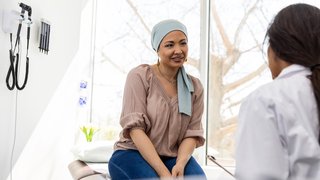What does skin cancer look like? Pictures, plus prevention tips
May 20, 2025

Skin cancer is highly prevalent and can affect anyone, regardless of age, nationality, or skin type. According to the Skin Cancer Foundation, more people are diagnosed with skin cancer each year in the U.S. than all other cancers combined, and 1 in 5 people in the U.S. will develop skin cancer by age 70. The foundation also estimates that the number of new cases of melanoma – the most serious type of skin cancer – diagnosed in 2025 will increase by 5.9% and the number of deaths due to melanoma will increase by 1.7%.
The majority of skin cancers are caused by sun exposure. Even if you apply sunscreen daily and are careful about sun protection, it’s important to examine your skin regularly for suspicious lesions, moles, and skin changes. Here’s a primer on what to look for during your self-exam.
Pictures to help identify 3 types of skin cancer
1. Melanoma
Melanomas can present in a variety of ways. They may be large and eye-catching or smaller than a pencil eraser. We often think of melanomas as dark brown or black, but they can be mostly light brown or even pink. Often, they are irregular in shape, but they also may be symmetrical and round.
Since early identification still provides the best chance for cure, at UT Southwestern’s Dermatology clinic, we recommend that patients conduct periodic, thorough skin self-exams and consult a dermatologist for any mole that is new or changing. Two concepts in particular can help guide self-detection of melanoma: The ABCDE test and the “Ugly Duckling” sign.
Identifying melanomas
There are some easy-to-remember guidelines when looking at skin lesions or moles and trying to determine whether it’s the beginnings of skin cancer. In this video, dermatologist Stephanie Savory, M.D., explains the ABCDEs of melanoma.
The ABCDE test
Melanomas often are referred to as irregular skin lesions – but what does “irregular” mean? The ABCDE test provides an easy-to-remember acronym describing five common characteristics of “irregular moles” that might be melanoma.

Asymmetry: If you draw a line through the mole, would the two halves look different? In other words, is the mole asymmetrical? If yes, it could be a malignant melanoma.
Borders: If a mole has scalloped, notched, or poorly defined edges, it could be melanoma. Also look for any instances where the border is uneven or dips out in certain areas.

Colors: One myth about skin cancer is that it has to be dark brown or black. But a melanoma can also appear blue, pink, red, or multiple colors and shades.
Diameter: The rule of thumb is that a healthy mole is no larger than a pencil eraser (about 6 mm) – but I’ve seen smaller melanomas as well.
Evolving: Melanoma generally changes at a different rate than background, normal moles. Between skin exams, does a mole look different? Is it larger? Has the color changed? That could be a warning sign of a melanoma. Also be aware of any new symptoms associated with the mole, such as itching or bleeding.
The Ugly Duckling sign
The idea behind the Ugly Duckling sign is that you tend to make moles that are unique to you and generally look alike. A mole that stands out from the “family” and doesn’t look like the others – maybe it’s a larger size, different color, or more irregular shape – may be melanoma. Remember that a melanoma can appear anywhere on your body (even the genitals and bottoms of the feet) so check all your skin, not just sun-exposed areas.
Related reading: 3 skin cancer treatments that might stop melanoma in its tracks

2. Basal cell carcinoma
This is the most common form of skin cancer. A basal cell carcinoma often appears as a firm bump on areas of the skin that are heavily exposed to the sun, such as the head/scalp, neck, and arms. Lesions might also bleed or appear scaly or shiny. They may be pink or pigmented, scaly or smooth. They often present as a change in the skin, such as a new growth or sore that won’t heal.

3. Squamous cell carcinoma
This cancer often appears on sun-exposed areas such as the scalp, ears, nose, lips, and hands. It can also present as a small, pink, round bump that might feel like it prickles or catches on clothing. It may be tender, painful, red-pink, scaly, or nodular. More uncommonly, squamous cell carcinoma can arise within chronic wounds, ulcers, or scars. They are frequently slow-growing but also may appear suddenly, seemingly out of the blue. Due to their immunosuppressed status, organ transplant recipients are approximately 100 times more likely than the general public to develop squamous cell carcinoma.
When to see a dermatologist, plus prevention tips
It’s important to catch skin cancer early for the best treatment outcomes, so consult a dermatologist for any skin change you feel is suspicious. If we discover a skin cancer, prognosis is often excellent with surgical excision alone. We work closely with specialized dermatologic surgeons as well as skin cancer experts in medical and surgical oncology at the Simmons Comprehensive Cancer Center.
Dermatologists are trained in the nuances of diagnosing skin cancer and unusual lesions. We can help you personalize a skin care routine and skin exam schedule based on your personal risk factors. We can also help you screen difficult-to-monitor areas such as the back, buttocks, and scalp.
And, like most cancers, prevention is key. Our dermatologists often recommend the following prevention tips to patients:
- Apply sunscreen every day. This is the No. 1 tip for preventing skin cancer. Use an SPF 30 or higher that is labeled “water-resistant” and “broad-spectrum” to cover for UVA/UVB exposure.
- Fully examine your skin, head to toe, on a regular basis.
- Wear sun-protective clothing such as long sleeves and broad-brimmed hats when outside. Ultraviolet protection factor (UPF) clothing is an excellent and convenient sun-protective resource.
- Limit sun exposure when UV rays are strongest (generally 10 a.m. to 4 p.m., though keep in mind that the sun is still often intense toward the later afternoon). Another way to think of sun avoidance: The sun is most intense when your shadow is shorter than you are. In this setting, you should ideally be indoors or double-covering outside with sunscreen on exposed surfaces and UPF clothing.
- Don’t forget about reflected and scattered UV exposure. UV light can reflect off water, sand, light-colored concrete, snow, etc. Therefore, even when outdoors under shade structures or during completely cloudy days, there can still be enough UV light reflected off surrounding surfaces to cause skin damage.
- Finally, you don’t have to burn to cause sun damage: Even just a few unprotected minutes in the intense sun can begin a cascade of sun damage to the skin.
The truth about tanning
Exposure to UV rays in any form can contribute to skin cancer. So it’s important to understand the risks with tanning and being out in the sun without proper skin protection. Dermatologist Stephanie Savory, M.D., talks about the myths surrounding tanning and skin cancer.
One more prevention tip: Vitamin D is made in the skin in part through sun exposure, and many patients think it’s safe to skip sunscreen to increase their vitamin D levels. However, the risk of developing skin cancer outweighs the potential benefits of sun exposure. Instead, increase your vitamin D levels by maintaining a healthy diet and taking supplements as recommended by your doctor.
To find out whether you or a loved one might benefit from seeing a dermatologist, call 214-645-2400 or request an appointment online.











